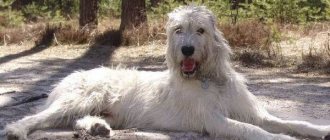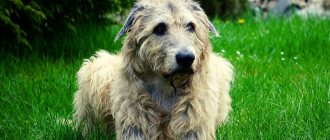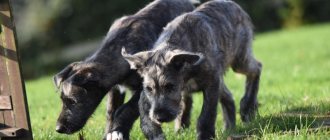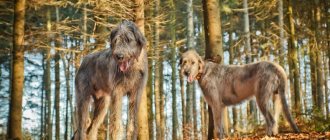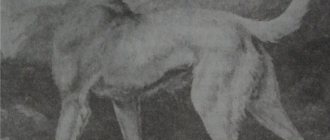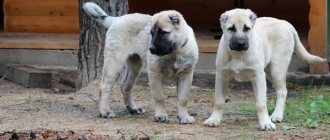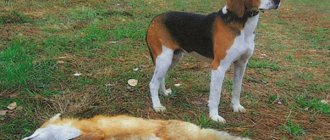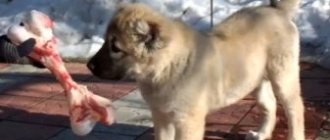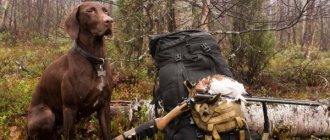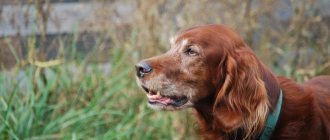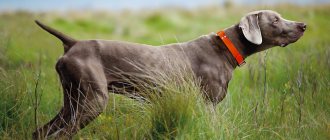Story
Even before our era, dogs appeared in the British Isles along with the Celtic people. Wolfhounds were valued and symbolized luxury: dogs were made into invincible heroes of legends, tales, ballads; warriors even protected themselves with armor depicting giants.
In 1641, dogs were sent to France as an expensive gift to Richelieu (a famous cardinal). Five years later, several wolfhounds were sent to the Italian Duke of Tuscany. Thus, the breed turned into a rich gift among the motley nobility.
The dogs earned their fame for their ability to hunt wolves. But by 1780, the last predator was caught in France. Then they started going out with dogs to hunt bears, moose, and deer.
The history of the state is intertwined with the past of the breed. Celtic tribes kept greyhounds, descendants of Irish greyhounds. Ancient people admired and used the size and speed of dogs.
Taigan
Taigan is a Kyrgyz greyhound. The beauty and power of Kyrgyzstan in the flesh - this hunting dog is similar to the Kazakh greyhound, but more powerfully built.
Taigan is ideal for hunting foxes, badgers, and mountain sheep.
He can hunt in the highlands without losing his working qualities. The main goal is to catch up and kill prey. The Kyrgyz hound is on the verge of extinction.
Description of the Irish Wolfhound
In contrast to their impressive height, wolfhounds are modest and friendly. Dogs become strongly attached to their owners and endure long separations painfully. The dog should be raised strictly, but love should be expressed in every possible way.
Irish Wolfhounds do not accept shouting or harsh punishments. Pets easily learn standard commands, but are not suitable as guards; they should not be forced to perform the function of a guard.
Wolfhounds are sensitive to children and do not show aggression towards those who are smaller and weaker. Dogs know how to control power and are friendly towards animals. The Irish are calm, they don’t cause pogroms in the house, they can be kept in an apartment.
Gampr
Gampr is an Armenian wolfhound. A typical Molosser, a type of Caucasian Shepherd Dog, native to Armenia - a large fluffy dog with a kind look and a pure heart. Unfortunately, the breed is not recognized by the FCI.
The main purpose of this dog is to serve a person; rest assured, he will become the “right hand”, trying to please and bring joy to the owner.
Gampr is a true mountaineer, a vigilant guard and a fearless rescuer.
Characteristics
The Irish Sheepdog is considered the largest dog in the greyhound family. The height at the withers is up to 79 cm, the pet’s weight can be 54 kg. The wolfhound's physique is muscular. The breed's coat is coarse and hard. Above the eyebrows and in the chin area it is longer.
Dog color options:
- black;
- brindle;
- ginger;
- blue (called gray tint);
- white.
Distinctive features
The Irish Wolfhound is a large dog with a long body proportional to the height at the withers . For all its large size, the dog does not look rough and massive. It is not in vain that it is included in the group of greyhounds; it is distinguished by dryness and leanness similar to them.
The standard specifies only the minimum required height for females and males: 71 cm and 79. There is also no weight limit - from 40 kg. The last standard was published in 2001. According to it, all dogs that do not meet the characteristics of appearance and character are discarded:
- The head is elongated, proportional to the body, not heavy. The occipital protuberance is weakly expressed, the frontal part is angular. The stop is deep enough. The skull is almost straight, the frontal bone is flat.
- The muzzle is fairly long, tapering towards the nose, wide and well filled. The bridge of the nose is straight. The jaws are strong and have a scissor or straight bite. Lips are thin black.
- The nose is large with developed open nostrils. Color – only black.
- The ears are small, drooping, and “pink-shaped.” They don't stop.
- The eyes are set wide apart at stop level. Rounded. The color of the iris is dark brown.
- The body is elegant, well built, dry. The back is long and straight, the loin is rounded. The croup is wide and sloping. The chest is deep and quite wide. The ribs are not flat, but not particularly round either. The withers are pronounced. The neck is long, straight, strong, without dewlap.
- The tail is set below the back line, quite thick and long. Curved at the end.
- The limbs are long, straight, muscular. The hock joints are low. Elbows are straight. The paws are set straight, not very large, rounded. Fingers are collected. The claws are black.
- The coat is long, hard, and wiry. Forms a beard under the jaw. The tail is covered with thick hair. The undercoat is soft.
- Colors: gray, white, brindle, all shades of red and red, black.
Breeding
Expert opinion
Anna Abramenko
An avid dog lover. Experience in veterinary medicine since 2009.
Ask a Question
The suitable age for mating wolfhounds is 2 years.
The best time for conception is the 11-15th day after the female starts estrus. Before this, you should not feed your pets; you should take them for a walk. The male and female are introduced on neutral ground. They mate with the male.
Dogs are re-mated after 24-48 hours. Pregnancy lasts 56-72 days. By the age of three, the number of Irish Wolfhound puppies in the litter increases.
Development and age-related changes
Up to 2 years of age, puppies grow quickly, gaining weight and increasing in size. Then they develop more slowly. It does not affect intelligence, learning or activity.
As dogs age, they can become irritable. “Old people” will increasingly prefer a quiet holiday in a cozy corner, but this does not mean that you can give up walks or pay less attention to your pet.
Raising and training the Irish Wolfhound
Your dog should be raised firmly but fairly. Obedience from the Irish Wolfhound must be achieved calmly and patiently. Dogs do not like screaming or physical influence. Young pets take a long time to get used to a new place and feel extremely insecure and wary.
The wolfhound is quite easy to train. The breed does not like boring monotonous training. The dog must be interested, otherwise attempts to achieve the command will fail. It often takes a long time to fight for your pet’s obedience.
Expert opinion
Anna Abramenko
An avid dog lover. Experience in veterinary medicine since 2009.
Ask a Question
The breed is characterized by self-sufficiency. Even with strong love for the owner, the Irish Wolfhound will prefer to remain that way. Therefore, it will be faster and more effective to achieve results in training your pet if the dog is praised rather than punished for disobedience.
During the growth period, it is important to provide your pet with good exercise. The dog needs to spend more time walking on solid ground. The ideal option for the Irish is running through fields and meadows. The preferred exercises are swimming and walking on sand.
Features of character and behavior
Irish Wolfhounds are calm, balanced pets, with a temperament similar to melancholic or phlegmatic people. They are kind to people to the core, restrained and tactful, never getting underfoot or creating discomfort.
These dogs are not designed to be fighting or guard dogs. They are not aggressive and do not feel anger toward humans or other animals. They are best suited as a companion, hunter, or racing dog (often competing).
Despite some clumsiness in movements, the breed is quite active. Loves to play and spend time with the owner and household members.
Photo of an Irish Wolfhound with a man
Advantages
- Irish Wolfhounds are reserved, phlegmatic and calm . They are good-natured and non-aggressive towards people and other animals. They love children and tolerate all their antics and bullying. They treat pets well, rather indifferently. They do not bark or create unnecessary noise.
- Such a dog will never impose itself or get in the way. It is important for them to be close to their owner, but they will wait patiently when a person needs their help. They are devoted to the family, giving all of themselves while serving people.
- Smart and hardworking. They will work hard on themselves in order to fully meet the level of the owner’s demands.
- Fast and hardy - a good breed option for participation in competitions and exhibitions. The dogs look original, are quite rare and cute.
Flaws
A big dog means a big responsibility. This pet loves his family very much and is constantly bored. He may become depressed and mope due to a long separation from his owner. The wolfhound needs a lot of attention. He is quite active and requires regular long walks.
- Melancholic temperament. The dog is prone to touchiness. She does not like family quarrels and scandals, and constant swearing will ruin the pet’s mental state.
- It takes a long time to mature . Emotional and physical maturity can only come at 2-3 years of a wolfhound's life.
- Requires serious training . Like all large dogs, he is dangerous only because of his size, so he needs proper training. The Irish Wolfhound can be willful and try to take the place of leader in the house.
- Loves to chase cats and pigeons , often gets off the leash, and is prone to running away.
Care and maintenance
The hard, wire-like hair with a soft undercoat perfectly protects the Irishman from the cold, mosquito and midge bites, dirt and humidity. Moreover, there is no unpleasant odor from the dog. It is easy to comb a wolfhound, and the dog does not have tangles.
Trimming
Trimming is a procedure by which dead parts of a dog’s hair are removed, giving the dog a well-groomed and neat appearance.
Stripping, a tool similar to a serrated knife in which the frequency and height of the links is different, is used to process the entire animal's fur. It is not sharp, acts as an index finger - designed to make it easier to pull out the dog's fur.
Combing
You should comb your pet 2-3 times a week to keep the coat in order, using a comb or brush made of high-quality bristles.
Positive effects of scratching:
- a massage that is pleasant for the dog;
- improving blood circulation in the wolfhound;
- removal of dead hair.
First, scratch your pet with a metal comb. Combing begins from the wolfhound's head, then moves to the body (particular attention is paid to the sides), then moves to the tail. At the very end, the dog’s limbs are scratched. The comb should be held at an angle.
Then you need to take a brush, walk it over the dog’s body against the coat and again in the direction of hair growth. Finally, remove dirt and dust with a damp cloth.
Bathing
The dog should be washed twice a year when it gets dirty.
It is better to use shampoo for coarse coats. It is allowed to clean with dry products: rub them into the wolfhound’s fur, then comb it with a comb.
It is recommended to rinse your pet’s legs and genitals in the shower after mating.
Care for paws, teeth and ears
An Irishman's claws need to be trimmed using a special tool - a claw cutter. If they are too long, they may cause discomfort for your dog when walking. A wolfhound's teeth require constant inspection. The gums should be pink, without bleeding. Brush the dog’s teeth once a week with a toothpaste specially made for dogs, using a brush or a finger attachment. To mechanically get rid of plaque, the dog is allowed to chew bones.
Your Irish Wolfhound's ears should be checked regularly. Inside the sink, they are wiped with a wet cotton pad to remove sulfur and dust.
Expert opinion
Anna Abramenko
An avid dog lover. Experience in veterinary medicine since 2009.
Ask a Question
If your dog has fluid leaking from his ear, shakes his head frequently, or has excess wax, it is recommended that you contact your veterinarian immediately.
After walking an Irish Wolfhound, the owner is advised to examine the dog's paws for injuries. The fur between the toes should be removed. In winter, it is better to smear the dog's foot pads with vegetable oil - it helps to avoid cracking.
Taking care of your eyes
Expert opinion
Anna Abramenko
An avid dog lover. Experience in veterinary medicine since 2009.
Ask a Question
Once a week, you need to wash your pet’s eyes with a cloth soaked in chamomile infusion (just warm water will do).
If your dog develops symptoms such as souring, excessive lacrimation, and redness, it is advisable to consult a veterinarian.
The wolfhound needs to finish the procedure with obligatory praise and a tasty treat.
Foods that dogs should not eat
- Fresh cow's milk;
- Chocolate;
- Onion and garlic;
- Raw river fish;
- Sweets;
- Butter, margarine;
- Sour cream;
- Sausage, smoked meat, salted lard;
- Boiled and raw bones;
- Pearl barley;
- Mushrooms;
- Vinegar;
- Seasonings and spices;
- Tubular bones of a bird;
- Bones of rabbits and sheep.
Pets' eyes also need care. They should be wiped with chamomile infusion at least once a week.
- Ears are cleaned of wax with cotton swabs and disks. Be sure to use veterinary lotion.
- Claws are trimmed as they grow.
- Use the teeth cleaning brush once a week.
- Dogs are prohibited from sleeping on hard surfaces.
Nutrition
A dog's diet should be balanced and rich in nutrients. The easiest way to decide what to feed your pet is to ask the breeder. Professionals will advise what to give and in what quantity to a particular animal.
Irish Feeding Options:
- natural food;
- dry food (premium class).
The advantage of the latter is that it saves time on cooking. Food for a wolfhound already contains the necessary components in the required ratio. The downside is the high price.
Natural dog food is also not cheap. It will take more time to prepare; you will need to independently calculate the amount of necessary minerals and vitamins. The advantage is that the owner knows exactly what his pet is eating.
Expert opinion
Anna Abramenko
An avid dog lover. Experience in veterinary medicine since 2009.
Ask a Question
You cannot mix two types of food: add dry food to natural food.
High-quality nutrition for a wolfhound plays a special role during the period of active development of the puppy. An incorrect diet contributes to rickets and slow growth of the pet. The number of meals depends on the age of the Irishman.
Until 45 days, the puppy is fed 6 times a day, from 3 months - 4, and from six months - 2.
The Irish Wolfhound should be fed at room temperature after a walk. The dog should always have fresh water. If the pet has not eaten its dinner completely, the food is put in the refrigerator until the next meal.
Useful natural products:
- boiled meat: beef, rabbit, chicken;
- sea fish;
- low-fat cottage cheese;
- buckwheat and rice;
- vegetables, fruits and herbs.
Foods that are harmful to your pet:
- bread;
- chocolate;
- legumes;
- sweet, very salty, seasonings;
- fatty meats, smoked;
- River fish.
Georgian Shepherd (Nagazi, Georgian Wolfhound)
- Origin: Georgia
- Height: from 61 to 66 cm
- Weight: from 46 to 68 kg
- Life expectancy: 11 to 12 years
- Temperament: Alert, protective, calm, confident, strong-willed, courageous, resilient
The Georgian Shepherd is a Molosser breed that was used as a working dog in the Caucasus. Nagazi are dogs with strong bones and an athletic build, a large head, furry ears, powerful limbs and a bushy tail. This breed was used to herd sheep, a tradition that continues to this day.
Georgian wolfhounds are descended from the ancient Molossian dogs and were primarily used as sheep protectors from predators. These rare dogs have even been exhibited at several dog shows. At some point their importance in Georgia declined and most of them were taken out of the country. However, dog lovers turned to the Ministry of Natural Resources for help and made efforts to revive this unique breed.
The herding and protective instincts of the Nagazi make them alert, brave, strong-willed and assertive dogs. They form close bonds with all members of their family, but do not accept or get along with strangers, making them excellent watchdogs . The Georgian Shepherd will also have a good relationship with the children she was raised with and will socialize well with the pet dogs in her family. However, when it comes to unknown dogs, nagazis become territorial. They are also not a good choice for homes with cats and other small pets.
This active breed needs regular exercise and requires long walks and plenty of play time. Georgian wolfhounds do not do well in apartments and prefer houses with a large yard or garden where they can run freely. When walking them, be sure to put a leash on your pet so that it does not run away at the sight of its prey.
IMPORTANT! Due to their dominant nature, Nagazis are not suitable for first-time owners and require a tactful trainer to train them firmly but gently.
Since Georgian Shepherds are wary of strangers, it is very important to socialize your pet from childhood, forcing him to meet different people and experience different situations. In this way, he gradually learns who to accept and who to be careful with. Introduce your nagazi to people who regularly visit your home as early as possible so that she can behave well when interacting with them.
Health and treatment
Pathological diseases are usually associated with the dog's genetics. The large size of the breed poses a threat to joints. In particularly large representatives of wolfhounds, the blood vessels and heart wear out faster. The table describes the pathologies found in the Irish.
| Disease | Manifestation | How to treat |
| Volvulus | Reasons: overfeeding, fast running and too active games, severe abdominal bloating, the dog categorically refuses to drink and eat | If the disease is diagnosed in time, surgery to remove dying tissue can save your pet. |
| Spinal cord injury (Wobbler syndrome) | At an early stage of development, a veterinarian can determine | Correction of food composition, prescription of vitamins and additional supplements |
| Inflammation in the elbow bursa | Filling of the mucous membrane with fluid, the “bump” in the elbow part is constantly growing, movement causes difficulties, the pet is limping | Pumping out liquid. Therapy with steroids. As a last resort, cutting the bursa surgically |
| Cardiomyopathy | Associated with loss of tissue elasticity. Shortness of breath, fainting, and the circulatory system work worse | Incurable, life should be maintained with special therapy |
| Hypothyroidism | Determined by laboratory tests | Prescribing hormonal medications |
| Skin diseases | They are provoked by staphylococcus and may itch. Spots appear on the fur | Give immunostimulating drugs, antibacterial agents |
Expert opinion
Anna Abramenko
An avid dog lover. Experience in veterinary medicine since 2009.
Ask a Question
Timely vaccinations will protect your pets from most diseases. The first one is given to an Irish puppy at 2 months.
Training
This breed is highly intelligent . Wolfhounds really strive to please their owner, so they quickly learn commands and are generally inclined to be obedient.
No harsh upbringing is required; the Irish grasp everything on the fly. Training, like socialization, should begin as early as possible. As soon as the dog can be released outside, training must continue outside the home.
values affection most of all ; for it this will be the best reward for successfully following a command.
Advantages and disadvantages
The main disadvantage of the dog is poor health, susceptibility to diseases of the joints and heart, and short life expectancy. Irish puppies take a long time to mature, reaching their prime after two years.
Advantages of the breed:
- flexibility and kindness;
- the friendliness of a wolfhound;
- dogs treat children well and do not growl at them;
- lack of aggression, approach strangers without fear or aggression.
Irish character
The largest wolfhounds in the world also happen to be some of the smartest dogs. The owners confirm that the main character traits of such a dog are restraint, tolerance, generosity, and kindness. The most interesting thing is that a wolfhound dog with its parameters can scare even an adult. But in fact, as dog owners say, they always bond with children, treat them with kindness and care, and become their families' best friends. When meeting smaller dogs that show an aggressive reaction, the Irish simply walk away without getting into a fight. If the enemy is large and strong, then they take a warlike pose, but do not be the first to get into a fight.
List of suitable nicknames
When choosing, you should focus on a simple, easy to pronounce name. The main thing is that you like it, then the pet will love its nickname.
What to name a boy: Karl, Vist, Luther, Vector, Jack, Tower, Tybalt, Knife, Dolon, Werther, Martin, Bernard, Gerimi, Dare, Georg, Booms.
Nicknames for girls: Sparta, Margot, Scarlett, Geraldine, Krista, Ladea, Hera, Mandarin, Vesta, Raffi, Baby, Lilith, Mackey, Troy, Alphys, Kailani.
Rules for choosing puppies
A healthy baby Irish Wolfhound is active and does not show aggression. His fur is shiny, his belly is soft, his eyes and ears are free of dirt, and his nose is cold. The little Irishman, raised according to all the rules, stands firmly on his paws.
The following features indicate marriage:
- soft back;
- lethargy of the dog;
- too light or heavy head;
- not black nose;
- short neck of a wolfhound.
Expert opinion
Anna Abramenko
An avid dog lover. Experience in veterinary medicine since 2009.
Ask a Question
It is better to purchase a wolfhound puppy from a nursery with all the documents. At the same time, you should make sure that the Irishman’s parents meet the established standards and are healthy.
Anatolian Shepherd (Kangal, Karabash)
In its homeland, Turkey, the kangal does not graze cattle, but carries out patrol, walking around the flock or climbing to high observation posts, from which one can better see and smell the predator.
As soon as they notice a moving object, be it even a car, they scatter in complete silence in a chain and rush towards it like a whirlwind. The tactics of such an attack are innate to them.
Puppy cost
The price depends on the puppy's pedigree. Irish dogs are a rarity for Russia; selling a real wolfhound for 20-40 thousand rubles. will not. The average cost of an Irish wolfhound is 67,000-74,000 rubles. If the dog's parents are medal winners, then the price is much higher.
Dog breeders in Russia:
- "Sunny wind";
- "From the Magic Forest";
- "Royal whim."
Vaccinations
The first vaccinations are given at 7-8 weeks, these are vaccinations against plague, adenovirus, parvovirus, leptospirosis, and parainfluenza.
Repeated vaccinations are given at 12 weeks of age, including the rabies vaccine.
As they grow older, the vaccination procedure is carried out once every year.
Class discord is not a barrier to real feelings
Interesting facts from the life of dogs
Some interesting information about the breed:
- Irish legislation of those times stated that wolfhounds could only belong to people of royal blood.
- There are legends about the Irishman's height. In the 20s of the twentieth century, a representative of the breed lived in England - Michael Broad-Bridge. The dog's height was 100.3 cm.
- The Irish have served in the Clover Leaf Guard since the beginning of the 20th century. Wolfhounds take part in ceremonial events, during parades, where noble people are glorified.
- In their homeland they say about the wolfhound: “Bold is like a lion and meek like a lamb.” Indeed, despite its frightening appearance, this big dog has a warm, kind heart.
What kind of breed is this?
Wolfhound is a dog breed that is divided into many subgroups. We can say that representatives of each individual species of wolfhound are fundamentally different from each other both in character and in appearance. This term is collective for all large and very strong dogs. This name originated in the past centuries, when people hunted wolves themselves, thus protecting their own economy. Only very large dogs could overpower these forest predators. Today, the functions that the wolfhound dog performs in society are not so cruel. They serve in government agencies, are pets of millions of families and do an excellent job as guards. It is also important to note that over the centuries the general character of these animals has changed. They have become less bloodthirsty, some species are even distinguished by unheard-of kindness, and in this regard they can be compared with Labradors.
Reviews
By nature, the Irishman is a loving, gentle, intelligent dog. But you need to be extremely careful not to accidentally offend the dog during training. Although it seems that the pet does not need commands, as if he already knows how to do everything.
The Irishman is unpretentious, living in an apartment, he behaves calmly. Feeding a wolfhound is expensive, due to the size of the dog. It is best to live with a pet outside the city: there he can walk peacefully without scaring anyone.
The wolfhound looks menacing in appearance, but is a very kind dog. Gets along well in a large family with children. Loyal, finds a common language even with cats.
What types exist
Species related to wolfhounds are not all recognized by the FCI. Only some of them are deservedly called purebred dogs.
Maremma Abruzzese Sheepdog
Laika (dog): types, what it looks like, breed description
A species of wolfhound with great growth: males up to 73 cm with a weight of about 45 kg. Character traits:
- calm;
- equilibrium;
- self-confidence;
- performance;
- responsibility and dedication.
Note! Animals are patient with children, can make their own decisions, and easily read the owner’s emotions.
Maremma Abruzzese Sheepdog
Russian greyhound
Who is this Russian greyhound? A wolfhound with tall stature and low weight - up to 85 cm at the withers and about 47 kg. The dogs have excellent physical characteristics, represented by:
- acute vision;
- subtle sense of smell;
- normal level of aggression towards wild animals.
Russian wolfhounds easily develop great speed. At home, they are calm and friendly.
Caucasian Shepherd Dog
The ancestors of Caucasians are considered to be the Tibetan Great Dane or individuals resulting from the mixing of Gampras and aboriginal dogs. Dogs have long guarded herds and performed guard duty. Rare migration and lack of mixing with other breeds allowed them to remain unchanged in appearance.
In purebred males, height starts from 68 cm, body weight - from 50 kg. Females are traditionally smaller: at the withers from 62 cm, weight from 45 kg.
Buryat-Mongolian wolfhound (hotosho-nokhoi)
The large dog performs guard functions and is distributed in Transbaikalia, Buryatia, Kazakhstan, China, Mongolia and Tibet. The ancient breed was used in pastures, to guard monasteries and private houses, and in hunting wolves. The Buryat-Mongolian wolfhound grows above 70 cm at the withers and has a corresponding weight.
Bankhars, as these wolfhounds are also called, have excellent health, they do not require special care, and easily adapt to an unfamiliar climate. They get along well with children and the elderly.
Buryat-Mongolian wolfhound
Pyrenean mountain dog
These are wolfhounds that appeared on French territory several centuries ago. Representatives are especially popular in Western Europe, the USA and China. Little is known about the breed in Russia. Adult males reach 80 cm in height and weigh no more than 54 kg.
Pets can serve as guards, shepherds and companions. They need long walks with moderate exercise. Dogs are wary of strangers, but never attack first.
For your information! The breed is used in rescue teams, rehabilitation centers, and as guide dogs. She has such unpleasant traits as resentment, especially for undeserved insults.
South Russian Shepherd
Dogs are distinguished by aggressiveness, endurance, and are capable of defense on an intuitive level. Puppies need to be trained from the first days they arrive in the home. The animals are not suitable for people who have not dealt with guard species. Average height is from 60-65 cm, weight - from 35-50 kg.
The Russian-Southern Shepherd will not obey a person with a weak character. Wolfhounds are able to make their own decisions and are loyal only to the unconditional leader.
Alabai (Central Asian Shepherd)
Aboriginal dogs spread to Central Asia more than 4 thousand years ago. For a long time the breed was called the Turkmen Shepherd; it became Central Asian only in the 19th century. The breed spread to Russian territory during the USSR.
Strong and brave pets are suspicious of strangers and are distinguished by their loyalty and reliability. The physical and intellectual development of its representatives ends by the age of 3. Alabais have a long-term reaction to external stimuli; in order to eliminate the problem, you need to get rid of the cause or switch the dog’s attention to a foreign object.
Central asian shepherd dog
Gampr (Armenian wolfhound)
Self-confident and independent dogs with a height of 67-79 cm and a weight of up to 80 kg. High intelligence and attempts at dominance require early socialization and training.
Important! The breed is not recommended for beginners; pets need a person with an unbending will. As a result of constant communication, friendly relations are established between the dog and the owner. The dogs' primary focus is on protecting younger family members and young animals.
Bavarian Wolfhound (Giant Schnauzer)
The animals are intended to help herd livestock. The main characteristics of the breed include:
- calmness, endurance;
- high intelligence, patience;
- ease of training.
Important! German Wolfhounds are not suitable for people who do not want to go on long walks in any weather. The mobility and activity of pets requires outdoor games.
Kyrgyz Greyhound (Taigan)
Belongs to the group of Central Asian greyhounds, can accompany hunters high in the mountains, and is capable of independently pursuing foxes and badgers. The Asian Wolfhound dog is not recognized by cynological associations and is an endangered species. Dogs with well-developed muscles, up to 70 cm in height, with a calm and balanced character.
The Kyrgyz hound is on the verge of extinction
Anatolian Shepherd (Kangal, Karabash)
Purebred Kangals live in Turkey and are recognized only by their canine organization. Puppies are difficult to remove from the country and cannot be bred in other states.
Anatolian Shepherd Wolfhounds are a mixture of Kangal and other herding dogs. Adults grow up to 81 cm and weigh about 65 kg. Animals can live outside year-round, but in severe frosts they will have to be brought indoors.
Note! Dogs have a developed sense of ownership; they will never allow strangers to touch their owner’s property. Dogs are friendly with children and can be used as a nanny.
Irish Wolfhound
The Irish descended from Celtic dogs, designed for baiting animals during the hunt. Mature males grow above 79 cm and weigh more than 54.5 kg. Pets are friendly and get along well with children.
Important! Irish dogs are not suitable for home guarding; they are good-natured towards strangers. They lack aggressiveness.
Kazakh Greyhound (tazy)
The Eastern or Central Asian greyhound is used for hunting and is not included in the FCI lists. Adults grow up to 70 cm and weigh less than 23 kg. The breed is characterized by:
- endurance;
- activity;
- elegance;
- speed of movement.
For your information! Dogs have increased independence and autonomy. Animals are not capable of vigorously expressing their joy.
Kazakh greyhound
Kazakh wolfhound (tobet)
Lives in the Far East, used for guarding and grazing livestock. It is an endangered species and is not recognized by the FCI. Mature individuals weigh up to 65 kg, reaching 60-76 cm at the withers. What a wolfhound looks like: large, hardy pets are not afraid of rain, cold or heat. They are distinguished by devotion, dedication, and lightning-fast reactions. The Kazakh wolfhound has no fear of wolves; the dogs are afraid of absolutely nothing.
Azerbaijani wolfhound (gurdbasar)
The herding dog is common in the mountain and steppe regions of Azerbaijan. A loyal breed that is loyal not only to the owner, but also to other family members. Smart dogs are easy to train and adapt to new living conditions. Can be used for guard and guard duty. The average height of males exceeds 72 cm, weight starts from 55 kg.
Georgian Wolfhound (Naghazi)
Not recognized by any canine society, according to the description it resembles a group of Molossians. The ancient Caucasian breed appeared in the 5th century. BC e. and has remained virtually unchanged since then. Dogs not only successfully protect livestock from predators, but can also serve as a shepherd.
Hardy, strong animals with good physical characteristics. They easily adapt to cold and heat and are unpretentious. The courageous and independent nature of pets helps them create an aura of confidence and calm. A stable and balanced psyche does not allow unnecessary aggression to manifest itself; dogs guard and herd livestock perfectly.
Mature individuals weigh from 52 to 75 kg, average height is from 72 to 77 cm.
A wolfhound dog is a powerful and dangerous weapon in the wrong hands. Without early socialization and proper training, an unlucky beginner may end up with a wayward, aggressive or completely unruly animal. Coping with a pet that weighs the same as its owner is quite difficult. Without an ODC course, an inexperienced owner will not be able to keep an interested dog, and he will quickly run away to get acquainted with local attractions.
Photo and video review
The Irish Wolfhound will respond to care, a gentle attitude and careful care with devotion and love. He will become an equal member of the family, a loyal friend and a true companion. Photos and videos of Irish wolfhounds.
The most common diseases
Irish Wolfhounds are extremely active. Their joints and blood vessels are at greater risk. Problems with the musculoskeletal system are the most common.
List of common diseases:
- Bruises, sprained paws;
- Osteochondrosis;
- Volvulus;
- Atrial fibrillation;
- Gastric volvulus;
- Ophthalmic diseases.
To avoid diseases, pets are vaccinated on time and monitored for daily physical activity and nutrition. Carry out regular inspections and consult with specialists.
